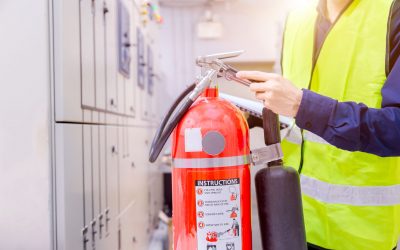Emergency Evacuation Plan
As the property owner or manager of a facility YOU are responsible for ensuring an emergency evacuation plan is in place.
This is a requirement in accordance with section 43 of the Work Health & Safety Regulation 2011 & failure to do so will result in penalties up to $30,000.
Your emergency & fire evacuation plan should consist of:
Evacuation Diagrams
Emergency Response Plan
Emergency Training
Evacuation Diagrams
As part of your fire & emergency evacuation plan you must have Evacuation Diagrams throughout your workplace.
Evacuation Diagrams are vital in ensuring your occupants and visitors are familiar with the location of fire safety equipment, the designated exit points and the emergency assembly point.
It is the responsibility of the Emergency Planning Committee (EPC) to ensure your workplace has up to date Evacuation Diagrams and failure to do so can result in huge fines. Evacuation Diagrams must comply with requirements of AS3745-2010.
In Queensland the Building Fire Safety Regulation 2008 has different requirements to other states and failing to comply will result in hefty fines. Contact us for information regarding exact Queensland requirements
Evacuation Diagrams – Who needs them?
A person conducting a business or undertaking at a workplace is responsible for ensuring Evacuation Diagrams are displayed throughout common areas.
This refers to:
- Building managers
- Property Owners
- Anyone managing a workplace or facility that may have occupants or visitors
Requirements of Evacuation Diagrams
As per AS3745-2010 Clause 3.5 here are a few of the compliance requirements:
Minimum Elements
- The title “Evacuation Diagram”
- The You Are Here location
- The designated exits & evacuation paths
- Fire Extinguishers & other fire equipment
- Location of the Emergency Assembly Point
- Validity Date
- A Legend of symbols used
- Location of facility including address & facility name if available
Optional Elements
- First Aid Kits, AEDs & other safety equipment
- Direction of opening of emergency doors
- Electrical Switchboard locations
- Fire Hydrants
- Evacuation Procedures – in accordance with the written Emergency Response Plan
Location
The Emergency Planning Committee (EPC) will determine the location and quantity of Evacuation Diagrams required.
Emergency Evacuation Diagrams shall be situated throughout common paths of travel and in areas where they will be readily available for occupants & visitors to read.
Size
Diagram with minimum elements only shall be at smallest size A4 with a pictorial representation of the floor area size minimum 200mm x 150mm or 30,000mm².
If the diagram consists of minimum & optional elements it shall be at smallest A3 with a pictorial representation of the floor area size minimum 300mm x 200mm.
As per AS3745 – 2010 Amendment 2018 for facilities with large floor areas such as shopping centres, hospitals, nursing homes etc. the floor plan must be divided into sections with no more than 2 exits per floor plan.
Orientation
Each Evacuation Diagram must be correctly orientation in regards to the You Are Here location and direction of egress. If an assembly area map is included it must have the same orientation as the rest of the diagram.
Install Requirements
All Evacuation Diagrams should be positioned at a minimum of 1200mm from the floor to the bottom of the diagram & no more than 1600mm to the top.
As a rule of thumb Evacuation Diagrams should not be fitted to fire/smoke doors unless a formal opinion has been obtained from a professional.
Contact The Emergency Evacuation Experts
Need assistance in developing Evacuation Diagrams for your business? Contact us today for a no obligation quote.
Frequently Asked Questions
How much are your Evacuation Diagrams?
Our Evacuation Diagrams are starting from $100+GST. Each job varies in amount of work involved – Is a site visit required? Are there existing evacuation diagrams?
Which areas in Australia do you cover?
We cover all states including but not limited to QLD, NSW, VIC, ACT, WA plus all major cities – Sydney, Brisbane, Melbourne, Canberra, Perth & more. Not in a major city? We got you, just reach out and we will see if we can help.
Will you come to our site?
Yes we will. However, if you’re budget is tight we can also work with you to provide us the required information & you can install the diagrams yourself.
When should my diagrams be updated?
Evacuation Diagrams must be reviewed every 5 years. Alternatively they must be updated anytime your fire/safety equipment changes or with any floor plan changes.
What format are the Evacuation Diagrams provided in?
All diagrams will be provided in electronic .PDF format & can also be provided in several hard copy materials – snap-lock frames, Laminated Paper, Aluminium Composite Material, Signwhite & several others.
Emergency Response Plan
A detailed & regularly reviewed written Emergency Response Plan paired with regular training and Evacuation Diagrams make for an extremely effective Fire & Evacuation Plan.
A well-planned emergency response plan could be the difference in saving your business thousands of dollars. Not only is there fines up to $30,000 for non-compliance but your business could be subject to natural disasters or in worst case scenarios loss of life.
In preparation of an emergency response plan the organisation must determine an Emergency Control Organisation (ECO). The ECO are the persons responsible to act during an emergency situation. Some example roles of the ECO may be Chief Warden, Wardens, First Aid Officers etc.
The EPC then prepares the Emergency Plan with documented responses in relation to relevant emergency risks. Some examples of these scenarios may be:
- Fire (building or bushfire)
- Flooding or other natural disaster
- Bomb Threat
- Armed Robbery or Terrorism
- Medical Emergency
- Chemical Spill
These are just a few of many possible risks & each workplace must be individually assessed to determine potential hazards.
In addition to the above the following may also be part of your emergency response manual:
- Emergency contact numbers including members of the ECO
- Types of first-attack firefighting equipment & how to use them
- Emergency Assembly Point
- Emergency Evacuation Procedures for giving instructions to occupants & visitors
- Copies of the Evacuation Diagrams
Contact The Emergency Evacuation Experts
Need some help in developing an effective emergency plan for your business? Contact Us Today.
Frequently Asked Questions
When should the Emergency & Fire Evacuation Plan be reviewed?
The Emergency & Fire Evacuation Plan must be reviewed annually as per AS1851-2012. Ideally the plans will also be reviewed after any emergency or whenever any building works or changes are made to the organisation.
What is the Emergency Planning Committee (EPC)?
The EPC are responsible for establishing & maintaining the fire & emergency evacuation plan
What is the Emergency Control Organisation (ECO)?
The ECO are appointed by the EPC to direct & control the implementation of the facilities emergency evacuation procedures.
What is a Personal Emergency Evacuation Plan (PEEP)?
A PEEP is an individualised emergency evacuation plan written especially for someone with a disability or mobility restriction that may require assistance during an evacuation.
Emergency Response Training
The final & arguably most important step of a fire evacuation plan is ensuring all staff & members of the facility are familiar with their roles & responsibilities.
As per AS3745-2010 emergency training should be conducted:
- For at least 1 member of the Emergency Planning Committee (EPC)
- For the Emergency Control Organisation (ECO) as per Clauses 6.3 & 6.5
- For facility occupants as per Clauses 6.4 & 6.5
Visitors and others who may not be workers at the facility must also receive information on the emergency evacuation procedures.
Frequency Of Training
Frequency of training should be as follows in accordance with AS3745-2010:
Emergency Control Organisation (ECO) Skills Training
ECO Skills training ensure members of the ECO are familiar with their roles & responsibilities as per the Emergency Response Plan. This should be completed at intervals not more than 6 months apart.
Occupants Skills Retention
Occupants Skills Retention enable occupants to act in accordance with the Emergency Response Procedures & shall be completed at intervals not more than 12 months apart.First-attack firefighting training
Where first-attack firefighting is included in your emergency evacuation procedures the occupants shall attend a skills retention activity at intervals not more than 12 months apart.Emergency Response Training (ERT)
Where a specialist Emergency Response Team (ERT) is required Emergency Response Training shall be completed at intervals not more than 12 months apart.Emergency Response Exercises
Site specific emergency response exercises shall be developed and rehearsed to ensure the effectiveness of the emergency evacuation procedures. Once the initial emergency response procedures are deemed satisfactory and the ECO have been trained an emergency response exercise should be completed within 12 months.Each area of a facility must participate in at least one emergency response exercise within a 12-month period. The type of occupancy, size & configuration of the facility will determine exact requirements in regards to the type & time between emergency response exercises.
How many fire wardens should we have in our facility?
There is no general rule though common practice is 2 fire wardens per 20 occupants. This is to cover if one warden is unavailable for whatever reason.
What are the different types of roles in the ECO and what colour apparel should they wear?
The ECO should be identifiable by the use of coloured apparel:
- White: Chief Warden, Deputy Chief, Communications Officers
- Yellow: Area/Floor Warden
- Red: Local Warden
- Green: First Aid Officers
Latest Blog Posts
Find out the latest info from our blog.
School evacuation procedures: keeping the community safe
It’s crucial for schools to have flawless evacuation procedures based on their unique needs. Schools come in all different shapes and sizes, which means careful planning should go into the evacuation procedure development process employed by every school. These also...
A strong emergency response plan is crucial to workplace safety
Workplaces can eliminate danger and minimise financial loss if they implement a strong emergency response plan. It doesn’t take an expert to understand that planning in advance is far better than reacting to something in the moment where everything starts to spiral...
Is your emergency evacuation plan up to scratch?
If you’re not 100 per cent certain your emergency plan is reliable, then it probably isn’t up to scratch. We simply can’t predict an emergency. Having a highly efficient and well-thought-out emergency plan is a business imperative, no matter how low the risk of...
Emergency evacuation procedures in the workplace – all you need to know
Whether your workplace is large or small, safety planning is crucial. The Work Health & Safety Regulation details that it is your responsibility as the business owner to prepare an emergency evacuation plan for your workplace. Emergency planning involves several...
Are your Evacuation Diagrams compliant with Australian Standards?
As per AS3745 & WHS 2011 your evacuation diagrams must follow certain requirements. Evacuation diagrams make it easier for people to evacuate in a fire, and are therefore an essential part of any Evacuation Plan. They have been proven to reduce the impact of an...
Evacuation plan for a small business – the ultimate guide
Don’t let a fire get in the way of the safety and productivity of your small business. An emergency response plan is a customised strategy considering all the risks to business in the event of fire. A strong evacuation plan will protect you, your staff and your...
Creating an emergency evacuation plan for a childcare centre
When dealing with young children, extensive consideration is required – after all, children are less able to follow directions, can be easily distracted and are less able to think independently. Here’s how to create a safe evacuation plan for your childcare centre.
How to create a hospital evacuation plan for staff and patients
Detailed planning and meticulous preparation is required to keep patients and staff members of a hospital safe in the event of an emergency. Here’s how to safely develop an evacuation plan for a hospital.
Emergency evacuation checklist for businesses
When an emergency strikes, it’s essential that your business can return to safety and resume operations with limited interruption. The key to achieving this is excellent planning, so you can act quickly and minimise risk effectively.









